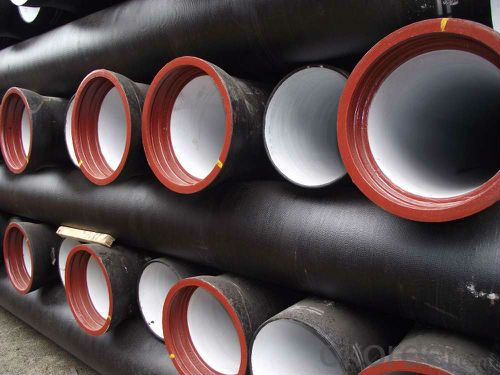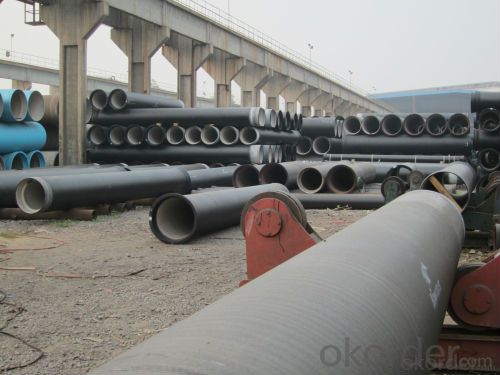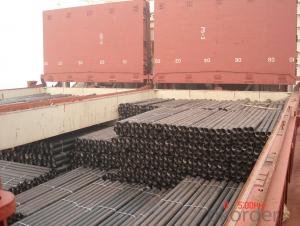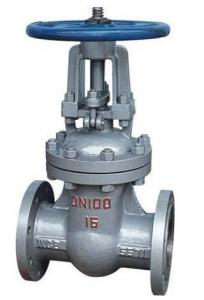Ductile Iron Pipe ISO2531:1998 C CLASS DN100
- Loading Port:
- China main port
- Payment Terms:
- TT or LC
- Min Order Qty:
- 20 m.t.
- Supply Capability:
- 100000 m.t./month
OKorder Service Pledge
OKorder Financial Service
You Might Also Like
1.Ductile Iron Pipe Description :
1) Pipes confirm to ISO2531,K9 class,T type joint,6m long,with inside cements lining conform to ISO4179, outside Zinc
spraying(130g/m2) and bitumen coating(70μm) conform to ISO8179.
2) Pipe ends: Spigot and socket ends, with 100% SBR rubber gaskets accoding to ISO4633
3) we can do third party inspection according to customer's request.
4) Our products have been sold to many international market, such as Middle East and South East Asia and Africa.
2.Main Features of the Ductile Iron Pipe:
1. Material: Ductile iron grade 500-7/ 450-10 in accordance with ISO1083
2. Standard: ISO 2531, EN545, EN598, ANSI, AWWA
3. Certificate: ISO9001, ISO14001, SGS, NSF, WRAS
4. Length: 6m or cut into 5.6m, 5.7m, 5.8m
5. Internal Lining: Cement, conform to ISO4179
6. External coating: Zinc + Bitumen, conform to ISO8179
3.Ductile Iron Pipe Images:


4.Ductile Iron Pipe Specification:
Standard: API SPEC 5L 44th eidtion,ASTM A252-98(2007)
Grade: A53 Grades A/B, ASTM A106 Grades B/C,ASTM A179 Weld Alternatives: LSAW
OD size range: 6.4~44.5mm
Wall thickness: 406.4~1422mm
Length: 3 - 12 m according to requirment
5.FAQ:
We have organized several common questions for our clients,may help you sincerely:
1.Q: Why would you choose ductile iron pipe rather than other pipe materials?
A:The reasons are obvious for that not only ductile iron pipe possesses the inherent strength and flexibility of ductile
iron, combined with proven corrosion protection systems, but also the cost savings can be achieved from design to
installation and commissioning.
2.Q:Why can you guarantee the inner of pipes can’t be corroded?
A: High alumina cement mortar lining and sulphate-resistant cement mortar lining. These two special linings are applicable
to inner anti-corrosion for sewage pipes, improving resistance to erosion of the sewage components.
- Q:What are the environmental benefits of using ductile iron pipe?
- There are several environmental benefits associated with using ductile iron pipe in various applications. Firstly, ductile iron is a highly durable material that can withstand harsh environmental conditions and has a long lifespan. This means that ductile iron pipes require less frequent replacements compared to other pipe materials, reducing the need for resource-intensive manufacturing processes and minimizing the disposal of old pipes. Secondly, ductile iron pipes have excellent corrosion resistance properties, which reduces the risk of leaks and pipe failures. This not only prevents potential water contamination but also minimizes the wastage of water resources. Additionally, ductile iron is a recyclable material. At the end of its useful life, ductile iron pipes can be melted down and used to manufacture new products, reducing the demand for virgin materials and conserving natural resources. Furthermore, the manufacturing process of ductile iron pipe has improved significantly over the years, resulting in reduced energy consumption and emissions. Today, many manufacturers use energy-efficient technologies and practices to produce ductile iron pipes, contributing to a lower carbon footprint and reduced air pollution. Lastly, ductile iron pipes have a smooth internal surface that minimizes friction and allows for efficient water flow. This can lead to energy savings in pumping and distribution systems, as less energy is required to transport water through the pipeline network. Overall, using ductile iron pipe can have a positive impact on the environment by reducing waste, conserving resources, minimizing pollution, and improving energy efficiency in water distribution systems.
- Q:Are ductile iron pipes resistant to chemical attacks?
- Generally, ductile iron pipes exhibit resistance to chemical attacks. The high corrosion resistance of ductile iron makes it suitable for a wide range of applications, including water and wastewater systems. To further enhance their resistance to chemical attacks, ductile iron pipes are commonly lined with a protective coating such as cement mortar or epoxy. This lining acts as a barrier between the pipe material and corrosive substances, preventing any degradation of the iron. However, it is important to consider that the level of resistance may vary depending on the specific chemical being transported, as well as the concentration and temperature of the solution. Therefore, it is advisable to seek the guidance of experts or engineers to ensure the appropriateness of ductile iron pipes for specific chemical environments.
- Q:Can ductile iron pipes be used for both water and wastewater applications?
- Yes, ductile iron pipes can be used for both water and wastewater applications. Ductile iron pipes are known for their durability, strength, and corrosion resistance, making them suitable for a wide range of applications including water distribution, sewage systems, and wastewater treatment plants. These pipes are designed to withstand high pressure and are capable of handling the flow of both water and wastewater. Additionally, ductile iron pipes have a long lifespan, reducing the need for frequent replacements and maintenance, which makes them a cost-effective choice for both water and wastewater applications.
- Q:Ductile iron pipe length is generally much
- The water-cooled metal ductile iron pipe has a single length of 6 meters, and the current mainstream ductile tubes are water-cooled metal ductile iron pipes.
- Q:What are the different methods for cutting ductile iron pipe?
- There are several different methods for cutting ductile iron pipe, depending on the specific requirements and constraints of the project. Some common methods include: 1. Manual Cutting: This method involves using a handheld saw or grinder with an abrasive cutting wheel to cut through the ductile iron pipe. It is a simple and relatively inexpensive method, but it can be labor-intensive and time-consuming for larger pipe sizes. 2. Mechanical Cutting: Mechanical cutting methods involve using specialized machinery to cut through the ductile iron pipe. This can include bandsaws, pipe cutters, or hydraulic cutting machines. These machines can provide faster and more precise cuts, especially for larger pipe sizes. However, they can be more expensive and require skilled operators. 3. Torch Cutting: Torch cutting, also known as oxyfuel cutting, involves using a torch to heat the ductile iron pipe and then introducing a high-pressure oxygen stream to create a chemical reaction that cuts through the metal. This method is effective for cutting thick-walled ductile iron pipe, but it can generate a significant amount of heat and sparks, requiring proper safety precautions. 4. Plasma Arc Cutting: Plasma arc cutting utilizes a high-velocity jet of ionized gas (plasma) to melt and cut through the ductile iron pipe. This method is ideal for cutting through thick-walled pipes where precision and efficiency are required. However, it can be more expensive and may require specialized equipment and training. 5. Waterjet Cutting: Waterjet cutting uses a high-pressure jet of water mixed with an abrasive material to cut through the ductile iron pipe. This method is highly precise and does not generate heat or sparks, making it suitable for cutting in sensitive environments. However, it can be slower and more expensive compared to other cutting methods. It is important to consider factors such as pipe size, project requirements, budget, and safety when selecting the appropriate method for cutting ductile iron pipe. Consulting with professionals or experts in the field can help determine the most suitable method for a specific project.
- Q:How do ductile iron pipes handle heavy traffic loads?
- Ductile iron pipes possess exceptional durability and have the ability to effortlessly withstand heavy traffic loads. This is primarily attributed to their remarkable strength and flexibility. The incorporation of graphite nodules in the composition of ductile iron allows for greater flexibility compared to traditional cast iron pipes. This enhanced flexibility empowers the pipes to endure substantial traffic loads, including the weight of vehicles traversing over them. Moreover, ductile iron pipes exhibit an elevated load-bearing capacity, enabling them to bear significant weights without experiencing any deformation or structural failure. Consequently, they are well-suited for deployment in areas characterized by heavy traffic, such as highways, bridges, and industrial sites. Furthermore, ductile iron pipes showcase exceptional resistance to external forces, such as vibrations and impacts. These pipes can effectively absorb and distribute these forces across the entire pipe network, thereby averting any potential damage and preserving the overall structural integrity. In conclusion, ductile iron pipes are explicitly engineered to manage the demands imposed by heavy traffic loads. Their strength, flexibility, and load-bearing capacity render them a dependable choice for infrastructure projects where durability and longevity are of utmost importance.
- Q:How long is the service life of the cast iron pipe, and the time of use of ductile iron pipes?
- Ductile iron is a new type of pipe, as long as we use it properly, the quality of its products, then the use of ductile iron pipes for 20-35 years, basically no problem. But whether it is ductile cast iron pipe, or some other things, the use of more years, and more or less, there will be some problems, ductile iron pipe can not escape the robbery. However, as long as we use the ductile iron pipe in the process of careful care, the service life of the problem is not to worry about.
- Q:Are ductile iron pipes suitable for use in chemical storage tanks?
- No, ductile iron pipes are not suitable for use in chemical storage tanks.
- Q:Method for joining cast iron pipes
- Cast iron pipe, cast cast pipe. Cast iron pipes are used for water supply, drainage and gas transmission lines. They include cast iron pipes and pipe fittings. Labor intensity is small. According to the casting method, it is divided into continuous cast iron pipe and centrifugal cast iron pipe, in which the centrifugal cast iron pipe is divided into sand mould and metal type two kinds. Divided into gray cast iron pipe and nodular cast iron pipe according to different material. According to the interface form, it is divided into flexible interface, flange interface, self anchored interface, rigid interface and so on. Among them, the flexible iron pipes rubber sealing ring; flange interface cast iron pipe flange fixed in the rubber pad, the flange gasket sealing; rigid interface cast iron pipe socket is large, straight pipe is inserted, sealed with cement, this technology has been basically eliminated
- Q:What are the different types of valves available for ductile iron pipe?
- There are several types of valves available for ductile iron pipe, including gate valves, butterfly valves, check valves, ball valves, and globe valves.
1. Manufacturer Overview |
|
|---|---|
| Location | |
| Year Established | |
| Annual Output Value | |
| Main Markets | |
| Company Certifications | |
2. Manufacturer Certificates |
|
|---|---|
| a) Certification Name | |
| Range | |
| Reference | |
| Validity Period | |
3. Manufacturer Capability |
|
|---|---|
| a)Trade Capacity | |
| Nearest Port | |
| Export Percentage | |
| No.of Employees in Trade Department | |
| Language Spoken: | |
| b)Factory Information | |
| Factory Size: | |
| No. of Production Lines | |
| Contract Manufacturing | |
| Product Price Range | |
Send your message to us
Ductile Iron Pipe ISO2531:1998 C CLASS DN100
- Loading Port:
- China main port
- Payment Terms:
- TT or LC
- Min Order Qty:
- 20 m.t.
- Supply Capability:
- 100000 m.t./month
OKorder Service Pledge
OKorder Financial Service
Similar products
New products
Hot products
Related keywords




























